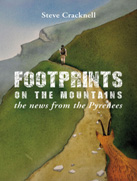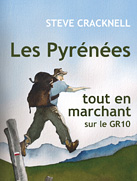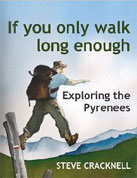Tout en marchant
Il n’y a pas de chemin ; le chemin se fait en marchant – Life is what you make it.
 This is a blog about the Pyrenees, walking, living in the south of France, and becoming français.
This is a blog about the Pyrenees, walking, living in the south of France, and becoming français.
I was brought up on the outskirts of industrial Middlesbrough, in the gritty English North, the son of a metallurgist who worked for Imperial Chemical Industries all his life. I studied engineering at university for two years. My destiny was to replicate my father: a hair-cut, a suit, a wife, and 2.4 children.
So how did I arrive here? Something to do with the spirit of 1968 ; I didn’t have to be like my father. Change was not only possible, it was essential.
Also, I had discovered the world of archaeology. Diggers were indeed dropouts. But they were also dedicated, hard-working, tough individualists: dropouts with a mission. It didn’t matter that they were badly paid, I wanted to be one.
A degree in archaeology followed and for several years I moved from one dig to another: Wales, Scotland, Germany. And then to Warwickshire to dig up Romans.
By 1982, however, archaeology had started to grow-up, cut its hair, and buy a suit. My girlfriend cut my hair, but the suit was my choice. Slowly I was sucked into the routine of a 9-5 job. Slowly I was becoming a replica. The mould that I thought I had broken was being reconstructed from the pile of sherds. It was gripping me ever more tightly, crushing the life out of me.
So I started designing websites and moved, in 1997, with my wife (the same woman who had cut my hair) to a small French village. We now live a few minutes from the Mediterranean, a trowel’s throw from Roman town of Narbonne, near to the medieval castle of Carcassonne – for archaeology still has an influence.
Let’s be clear about it: I am not an expatriate, I’m an immigrant.










Hi Steve – we are a school travel company looking to do the Hendaye to St Jean Pied de Port section end of April. Just a quick question – is it possible this time of year for this section and which way to do the trek – preference mountains to coast or coast to mountains. thanks, Tim
Hi Tim,
You can probably do this section but you may encounter a little snow at the end of April. Walk from the coast but plan alternatives after Ainhoa in case there are problems. I’m assuming the kids are 13+
best wishes
Steve
Hi Steve,
I work for an adventure mapping company called FATMAP (fatmap.com) and we are in the process of putting “epic” long hikes like the GR10 into our map. I’ve written a short summary of the route and we’d love to display a line on our mapping software showing exactly where it goes. Would it be possible to use your GPX data please? It would save me roughly 55 days of work hiking the route with my GPS!
Thanks,
Charlie
Hi Charlie
The GPS tracks on my site come from GR-info, so you should contact them. However, I recommend you compare and combine the track with more recent data from wikiloc.com. If you are interested in the GR11 in Spain which I walked in 2012-14 you will find the GR11 track here.
best wishes, Steve
Great stuff, thanks for your help Steve. And enjoy France!
Hi Steve – my wife and I, in our 70s, plan to walk the Freedom 4-day route, Aulus-les-Bains to Bidous to Graus to Certascan and back to Aulus-les-Bains. In New Zealand I’m finding it hard to find detailed information on the last leg, Certascan to Aulus-les-Bains, which is apparantly the hardest leg. But in what respects is it hard? I see the altitude differences and there’s obviously some strenuous effort involved but is this what makes it hard?
We’ll be doing this leg on 9 July this year – are we likely to need need crampons?
Is the route well-trodden? Or well marked?
We are reasonably fit and reasonably experienced trampers. I walked the Haute Route from Hendaye to Banyules over 7 weeks in 2013. Is this leg comparable to any part of the HRP?
We’ll be equipped with a GPS, maps, PLB etc.
We’ll be very grateful for any comment you can offer.
Regards, Adrian
Hi Adrian
I did the Mountains of Freedom trek in 2015. You will get an idea of what it is like from my description.
It isn’t the climbing and descent and distance that is difficult, though that counts obviously. The problem is the large blocks that you have to hop between on the way down from the Port de Guiló. As I noted the waymarking was improved a couple of days after our crossing. But the blocks are going to be a problem whatever.
At the time you are going there could be some residual snow north of the col (hopefully not much). As it is likely to be soft by the time you get there you will need to be careful in case it covers holes between the rocks.
In terms of the HRP, I remember a similar interminable field of boulders on a climb between Somport and Pombie.
But I do have a soultion! You can break the day at the free hut at the Turron d’Ars. I’ve never stayed there but you can ask the hostels to confirm that it still exists. The pics look perfect.
As for carrying crampons, contact Bordes de Graus a few days before and ask about conditions. Angels can speak/write some English. Or Certascan/Aulus.
By the way, I think that the Romedo de Dalt lake is one of the most beautiful in the Pyrenees.
I would be grateful if you can let us know the conditions you encounter as lots of people will be setting out at that time and the information will be very useful.
Have fun.
Thanks Steve for the information. I am astounded to get such a prompt reply! Your description and photos have given me a much clearer understanding of this leg of the route. There were a couple of testing boulder fields on the HRP and I remember how they chewed through the time. We can’t plan to overnight in the hut at Turron d’Ars as we have a tight timetable, but it’s comforting to know it’s there. I know – it’s a risk not having a weather day up our sleeves!
I will indeed let you know how we get on. (In passing, I’d like you to know that it was a relief to finally find a website that is so user-friendly, up-to-date and informative – well done!)
Thanks again.
I am sure this has been asked many times before. Why is walking the GR10 West to East more popular than the other way?
Great infos on your website. Thank you.
Hi Mo
I think the main reason is that most of the guidebooks are written like that. People also argue that W-E you have the wind and rain on your back. Others argue that W-E you are blinded by the morning sun! If you like meeting people and getting to know them over a few days walking, do W-E. It also gives you a safety net. On the other hand walking E-W you will see more nature.
I hope this helps.
Hi Steve,
Thanks for all your very helpful advice.
With my wife in July/August, we’re planning to walk the section Cauterets to Luz-St-Sauveur via Hourquette d’Ossoue (partly due to your recommendations – thanks!) and then back to the car in Cauterets via the ‘regular’route.
Questions:
1/ We had a hairy experience with electrical storms on the GR20 – can we expect the same type of storms at the end of day in the Pyrenees? People are’warning’ us!! We’re more used to the Alps where electrical storms are not very frequent (or if they are, they’re generally predictable/avoidable)
2/ If we have days to add to the trek, would you add them before Cauterets or after St. Luz? The western bit or the eastern bit of the GR10? We might also hire a guide to climb Mt. Vignemale.
Thank you.
It’s a real pleasure reading your web-site.
Best regards,
Mark
Hi Mark
Yes you can expect electrical storms in the Pyrenees at the end of the day. Not every day. The important thing to note is that they rarely start before 16h00. So if you get up at dawn, you will be at your destination by then. It will also be cooler walking.
East of Luz gets you into the Néouvielle Nature Reserve. Wilder than west of Cauterets.
As for Vignemale, the classic way to do it is to stay at Bayssellance, climb Vignemale and then either stay at Bayssellance another night or go straight down to Gavarnie (but this would make a very long day). You would need to book Bayssellance and the guide now to have a chance of getting in.
Great project!